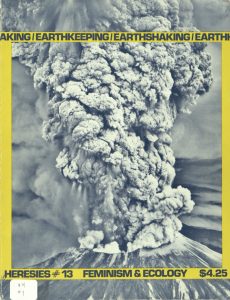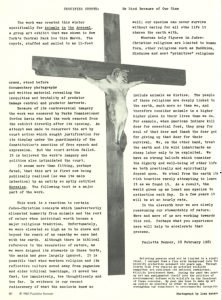In 1981, the radical feminist periodical Heresies published a themed issue titled “Earthkeeping/Earthshaking,” illustrating how the domination of Mother Earth is connected to the domination of women by the patriarchy. This issue was situated in the turn of the new decade in the 1980s, when the New Right, emboldened by the inauguration of President Ronald Reagan encroached upon the environmental acts enacted in the previous decade in the 1970s. The editors determined to encompass
The necessity for feminist theory to integrate social life, history, and natural environments; the art women are doing in and about nature; the equal importance of rural and urban ecologies; the contribution of women to the growing awareness of needs of nature; the relationship between women and militarism and struggles for liberation; and the exploitation of Third World countries for profit. (2)
This issue argues that although women have been socially shackled to their biological functions through their association with Mother Earth, acknowledging the parallels between the oppression of women and nature can lead to the upheaval of patriarchal systems and a radical reversal of structures of power.

The cover of Heresies’s themed issue titled “Earthkeeping/Earthshaking,” published in 1981.
The cover is a photograph of Mt. St. Helens because “she” is both nurturing and destructive. This ties in with why the issue is called “Earthkeeping/Earthshaking” because feminists aim to both dismantle the patriarchal system guilty of raping the Earth and protect Mother Earth from further destruction. According to Native American mythology of the Klickitat Nation, the volcano is Loo-Wit, an old woman and fire keeper who “mediated a dispute between two individuals by sharing her fire,” transforming her and the two leaders into Mt. St. Helens, Mt. Hood, and Mt. Adams. The eruption of Mt. St. Helens the year before in 1980 is a symbol of the “revolt of nature” because the editors know the significant role “feminist culture will play in that revolution” (2).
In the article “Energy Modes: Towards a Harmony of the Biosphere,” Lorna Salzman criticizes industrial society and its prioritization of infinite material growth at the expense of finite resources on planet earth. The utopian promises of industrialization, such as the end of poverty, disease, illiteracy, and hunger, have yet to be fulfilled, as inequities of distribution of material wealth between Western industrial society and the Third World have only increased. Salzman calls upon us to reject our religious faith in technology, which also entails “rejecting the Faustian bargain wherein we [attempt] to control the very processes of Nature” (34). Indeed, if the roots of the environmental crisis are embedded in our relationship to nature, the limits to growth and our use of the earth’s resources, then society must reject the global consumerist economy that sees the biosphere as an infinitely expanding, utilitarian resource to be exploited by mankind.

“Crucified Coyote: He Died Because of Our Sins” by Paula Nenner, printed in Heresies’s themed issue titled “Earthkeeping/Earthshaking.”
The “Crucified Coyote” is “a reaction to certain Judeo-Christian concepts which inadvertently alienated humanity from nature” when anthropocentrism became a major religious faith (Nenner 80). While Judeo-Christian traditions solely depict humans as holy figures, elevating humanity to be above and beyond the reach of empathy with the earth, other religions, such as Indigenous faiths, include animals as deities. The practitioners of these religious faiths are deeply connected to the earth and revere its inhabitants as the incarnation of god. For instance, when Native Americans hunt deer for sustenance, they pray for the soul of the fallen deer and thank the earth for helping them to survive. However, Western society treats the earth and its inhabitants as utilitarian resources to be exploited. Only when the last tree has been cut, the last river has been poisoned, and the last fish has been caught, only then will mankind realize that one cannot eat money.
This special issue of Heresies, “Earthkeeping/Earthshaking,” contributed to the women’s liberation movement during its second incarnation by embracing the ecofeminist ideal that the women’s liberation movement and ecological concern are intrinsically connected, and that the only solution to end the exploitation of Mother Earth is to dismantle the patriarchy and to resurrect a culture of harmony with all living beings. This periodical contributed to the women’s liberation movement and the emerging environmental movement by laying the framework for a sustainable future envisioned by the collective power of women. By invoking the “earth’s revenge” brought about by patriarchal value systems, this publication highlights how women from all walks of life are forging a new world of harmonious reciprocity with the earth in the wake of the imminent sixth mass extinction of the Anthropocene. Today in the 21st century, when climate change threatens to end life on earth as we know it, it is more important than ever for feminists to assert an ecological perspective that recognizes the interconnectedness of all living beings and to transcend the false dualism between nature and culture. How can we transform the oppressive connection between women and nature into one that is empowering?
Sources:
“Earthkeeping/Earthshaking.” Heresies: A Feminist Publication on Arts and Politics, vol. 4, no. 1, July 1981.
“Editorial Statement 13.” Heresies, vol. 4, no. 1, p. 1
King, Ynestra. “Feminism and the Revolt of Nature.” Heresies, vol. 4, no. 1, pp. 12-15.
Nenner, Paulette. “Crucified Coyote: He Died Because of Our Sins.” Heresies, vol. 4, no. 1, p. 80
Salzman, Lorna, “Energy Modes: Towards a Harmony of the Biosphere.” Heresies, vol. 4, no. 1, pp. 34-36.
